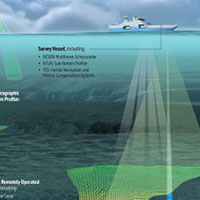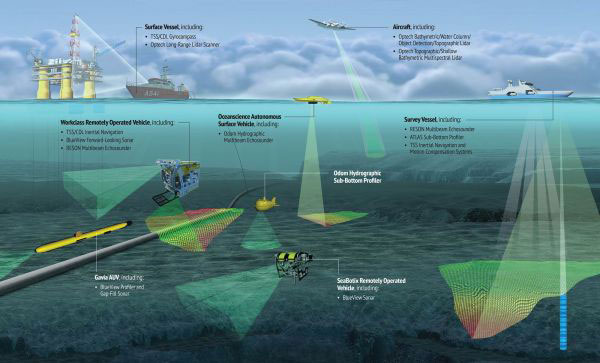Career Guide: Hydrographic Surveyor

In this first post in our series of offshore career guides, we take a deep dive (no pun intended) into the role of a hydrographic surveyor.

Hydrographic Surveyor Job Summary
Hydrographic surveyors—also called hydrographers— measure, map and collect data on the topography of underwater environments with the use of cutting-edge specialised equipment and advanced techniques to produce detailed charts and maps describing the physical features of riverbeds, shores and the sea floor.
Hydrographic surveyors create models and acquire data for:
-
Nautical navigation
-
Offshore resource location such as gas, oil, and minerals
-
Search and recovery for marine salvage, emergencies, and military operations
-
Construction of harbours, oil rigs, bridges, pipelines, and offshore wind farms
-
Planning of communications infrastructures, such as underwater cables and transmitters
-
Plotting for aquaculture
-
Reviewing new shipping routes
-
Dredging
-
Monitoring impact of natural and man-made underwater activity such as erosion and industrialisation
The tools hydrographic surveyors use include:
-
Global positioning systems (satellite and terrestrial),
-
SONAR, single and multibeam echo sounders
-
Remote-operated and autonomous underwater vehicles
-
Laser scanner and LiDAR-equipped aircraft
-
Geographical information systems
Apart from their main job of surveying aquatic geography, hydrographic surveyors are also expected to:
-
Integrate, process, and present collected data clearly to clients
-
Interact directly with clients in providing reports and tenders
-
Act as vessel-based managers for onshore and offshore projects
-
Resolve problems and technical issues with onshore and offshore teams
-
Inspect and revise current company procedures and projects
-
Evaluate in-house development and training courses
Hydrographic Surveyor Working Hours and Environment
The nature of hydrographic surveying is demanding. Hydrographic surveyors typically work for 150 days a year, and working hours can be as long as 10 to 14 hours a day.
Depending on whether a hydrographic surveyor is stationed on or offshore, their schedule can range from unsocial hours to a regular 9 AM to 5 PM shift. Senior surveyors, meanwhile, are expected to be on-call over the weekends and national holidays in case of offshore emergencies that require their level of expertise.
Hydrographic surveyors on offshore platforms generally work from April to October with no break. Weather conditions greatly affect hours, with tides and daylight also determining when they can work. Work usually slows down during the winter season.
Offshore workspaces and living quarters can be cramped. Hydrographic surveyors out in the field have to deal with long periods away from home and little to no time for socialising outside work.
Living near the main office is recommended but not necessary, as getting to ports and platforms require air travel provided by the company.
Working with an international crew is not uncommon. Onshore and offshore work opportunities abroad require being able to coordinate and cooperate with people from diverse cultural backgrounds.
Hydrographic Surveyor Job Entry and Qualifications
Having a degree for any of the following subjects is a solid starting point to enter the hydrographic surveying profession:
-
Geography
-
Geology
-
Computer science
-
Software engineering
-
Civil engineering
-
Environmental engineering
-
Land surveying
-
Marine science
-
Marine geography
An undergraduate degree in mathematics, statistics, operational research, or physics is also useful but should be complemented with a relevant postgraduate degree such as:
-
Hydrographic surveying
-
Hydrography
-
Geomatics
-
Geographical information systems
It is important to check if the course is accredited by the Royal Institute of Chartered Surveyors or the Chartered Institute of Building.
Industrial training placement and holiday schemes help develop practical skills and count as relevant experience that employers will value along with qualifications. Qualified land surveyors, meanwhile, can shift to hydrographic surveying by acquiring a postgraduate or Master’s degree in hydrography.
The Royal Navy also needs hydrographic, oceanographic, and meteorological specialists, so it is possible to start in the military and transition to the private sector with the right experience.
A valid driving licence is often required of most hydrographic surveyor roles.
Employers expect their hires to have the following skills and characteristics:
-
Logical thinking
-
Practical problem-solving
-
Adaptability
-
Resourcefulness
-
Resilience
-
Patience
-
Focus
-
Willingness to work with a team
-
Financial and legal expertise, specifically of maritime law, is a plus
Hydrographic Surveyor Salary
An entry-level hydrographic surveyor can have an annual salary starting from £16,000 to £25,000 when working in the region. An allowance of £70 to £110 is usually granted for each day spent working offshore, which can add £10,000 to £15,000 to the basic pay.
An experienced hydrographic surveyor can have an annual salary starting from £25,000 to £50,000 when working in the region. Offshore allowances can add as much as £25,000 to the basic pay.
A senior, chartered, or master hydrographic surveyor can have an annual salary starting from £45,000 to £60,000 when working in the region. For freelance surveyors, the offshore day rate can be as much as £300 to £500.
These figures are dependent on the location, market conditions within the industry, and level of responsibility. Hydrographic surveyors specifically working in offshore stations for oil & gas companies tend to have their salaries directly affected by the price of oil or gas.
A hardship allowance can also be given to hydrographic surveyors on top of the offshore allowance. The amount is dependent on the working conditions and the risks involved if the surveyor has to live in the offshore station.
Travel to and from project areas are generally covered by employers.
Hydrographic Surveyor Training and Development
Newly hired novice hydrographic surveyors undergo company training in foundational courses such as seamanship and equipment handling.
Offshore work requires applicants to pass a medical examination every two years and an offshore survival course like the Basic Offshore Safety Induction and Emergency Training Certificate (BOSIET). Certain skills like first aid, firefighting, helicopter underwater escape training, and safety at sea will be learned on the job.
Chartered or professional membership with any of the following organisations will greatly improve the chances of advancing one’s career in hydrographic surveying:
Membership in such professional bodies opens up opportunities to network with peers and superiors. Updates on the goings-on of the industry are regularly shared. Members can also take advantage of the educational programmes and events run by these organisations.
Hydrographic Surveyor Employment Prospects
Hydrographic surveyors can find work with the following employers:
-
Port and harbour authorities
-
Local and national government authorities
-
National charting agencies
-
Military organisations
-
Coastal protection agencies
-
Contract survey companies
-
General contracts
-
Specialised contracts (e.g. offshore geophysical and coastal engineering projects)
-
Client survey companies
-
Private companies in mining, energy, and construction
-
Dredging companies
-
Pipe and cable laying companies
-
Equipment development companies
-
Software houses (requires a minimum of four to five years of experience)
-
Academic research institutes
-
Organisations involved in land reclamation
Recruitment agencies are the primary channel by which contract survey companies hire talent. Freelance work and consultancies are also lucrative options for experienced hydrographic surveyors.
In the UK, freelance hydrographic surveyors tend to take contract work in England during the summer and in the southern hemisphere during the winter.
Offshore Opportunities
Employment opportunities are plentiful abroad.
The Norwegian Continental Shelf is still one of the busiest areas in the offshore industry, with operations in the North Sea, the Norwegian Sea, and the Barents Sea.
In the United States, offshore work is concentrated in the western and central Gulf of Mexico, along Louisiana, Alabama, and Texas, as well as by the Arctic Ocean near Alaska. In Latin America, the Orinoco Petroleum Belt, the Gulf of Venezuela, and the Gulf of Mexico are offshore hotspots.
There are developments in the Angolan and West African deepwater fields. The coastal areas of the Arabian Gulf also continue to be a hub of offshore work. Meanwhile, China has offshore work along the Bohai Sea, the East China Sea, and the South China Sea.
Career Trajectory
A hydrographic surveyor’s career generally starts as a trainee in a company, taking courses on the engineer or geophysicist track. Upon completion of training, the trainee becomes a full-fledged surveyor. With a couple of years of experience under their belt, they can be promoted to senior surveyor.
The next step up for a senior surveyor is becoming a principal surveyor and taking on a more managerial role, either as party chief or project manager.
Managerial-level positions for hydrographic surveyors are rare, so senior surveyors go down alternate paths to further their careers. Specialisation in technical support and development is one such path. Other surveyors move laterally within the company structure, filling roles in client liaison, time management, offshore management, health and safety, procedural matters, and overseeing staff.
Senior surveyors with five to ten years of experience under established companies can also forge their own path by freelancing, consulting or even starting their own business.
If you are looking to start your career as a hydrographic surveyor, take a look at our jobs page where you can find on and offshore opportunities for varying levels of experience.